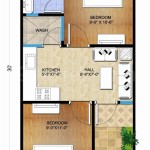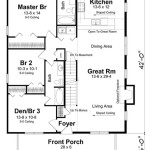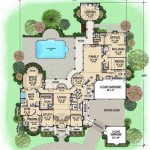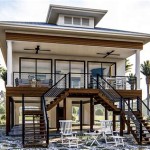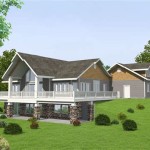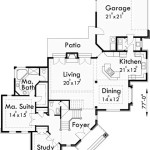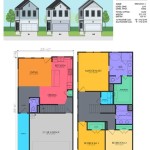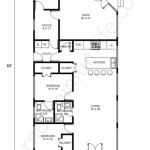Home Plans Under 500 Square Feet: Maximizing Space and Functionality
The increasing popularity of small homes under 500 square feet reflects a growing interest in minimalist living, affordability, and reduced environmental impact. These compact dwellings, often referred to as tiny homes, micro-houses, or small-scale apartments, require careful planning and innovative design to effectively utilize every inch of available space. Successful small home plans prioritize functionality, storage solutions, and a sense of openness to create comfortable and livable environments.
Designing for a small footprint necessitates a shift in perspective regarding spatial needs. Traditional notions of ample square footage for separate living areas, large bedrooms, and expansive storage are often replaced with multi-functional spaces, convertible furniture, and vertical organization. The focus moves toward efficiency and intentionality, encouraging dwellers to declutter and prioritize essential belongings.
Key Considerations in Small Home Design
Several key considerations are paramount when developing home plans for structures under 500 square feet. Addressing these aspects early in the design process is crucial for creating a functional, comfortable, and aesthetically pleasing living space.
Space Optimization: This is the most critical aspect of small home design. Every area must be carefully considered to maximize its utility. Open floor plans are frequently employed to create a sense of spaciousness and allow for flexible use of the available area. Multi-functional furniture, such as sofa beds, folding tables, and storage ottomans, plays a vital role in minimizing clutter and converting spaces for different purposes. Vertical space is often utilized to its full potential with shelving, loft beds, and tall cabinets.
The strategic placement of windows and doors can also significantly impact the feeling of spaciousness. Large windows allow natural light to flood the interior, making the space feel brighter and more open. The orientation of the home to maximize sunlight exposure can reduce the need for artificial lighting and contribute to energy efficiency. Door placement should minimize obstruction and optimize traffic flow within the small footprint.
Storage Solutions: Limited square footage demands creative and efficient storage solutions. Built-in storage is a common strategy, utilizing space under stairs, within walls, and in other otherwise unused areas. Vertical storage, extending from floor to ceiling, maximizes the use of wall space. Shelving units, cabinets, and drawers should be designed to fit the specific needs of the inhabitants, considering items such as clothing, kitchenware, and personal belongings.
Modular storage systems offer flexibility and adaptability, allowing residents to reconfigure their storage as their needs evolve. Storage containers that can be stacked and easily accessed are also valuable for organizing items and keeping the space clutter-free. Furthermore, incorporating storage into furniture, such as beds with drawers underneath or benches with built-in compartments, can significantly increase storage capacity without sacrificing living space.
Natural Light and Ventilation: Adequate natural light and ventilation are essential for creating a healthy and comfortable living environment in a small home. Large windows, skylights, and strategically placed doors can maximize natural light penetration, reducing the need for artificial lighting and creating a more cheerful atmosphere. Proper ventilation helps to regulate temperature, prevent moisture buildup, and improve indoor air quality.
Cross-ventilation, achieved by positioning windows on opposing sides of the home, allows for natural airflow and can reduce reliance on air conditioning. Exhaust fans in the kitchen and bathroom help to remove cooking odors and moisture. In warmer climates, shading devices such as awnings or overhangs can help to control solar gain and keep the interior cool. Thoughtful planning of natural light and ventilation contributes significantly to the overall comfort and livability of a small home.
Common Floor Plan Configurations for Small Homes
While customization is common, certain floor plan configurations are frequently employed in small home designs to maximize efficiency and functionality. Understanding these common layouts can provide a foundation for developing custom plans tailored to specific needs and preferences.
Open Concept Studio: This is perhaps the most common floor plan for homes under 500 square feet. A single, open space serves as the living area, bedroom, and kitchen. The bathroom is typically the only enclosed room. The open concept design maximizes the feeling of spaciousness, but requires careful zoning and organization to prevent the space from feeling cluttered. Furniture arrangement and area rugs can be used to define different functional zones within the open space.
Storage solutions are particularly important in open concept studios. Built-in shelving, multi-functional furniture, and vertical storage units help to keep the space organized and clutter-free. The kitchen is often designed with compact appliances and streamlined cabinetry to minimize its footprint. Overall, this layout creates a flexible and adaptable living space that can be easily reconfigured to suit different needs.
Loft with Separate Living Area: This configuration separates the sleeping area into an elevated loft space, freeing up floor space for a dedicated living area. The loft is typically accessed by a ladder or stairs, and the space underneath can be used for storage, a workspace, or other functional purposes. The separate living area allows for more defined living and sleeping zones, providing a greater sense of privacy and organization.
The height of the loft is a critical consideration, as it must be tall enough to allow for comfortable movement and headroom. The design of the stairs or ladder is also important, as it should be safe, easy to use, and not take up too much valuable floor space. This layout is particularly well-suited for individuals or couples who appreciate a separate living and sleeping area within a small footprint.
One-Bedroom Apartment Style: This configuration includes a separate bedroom, living area, kitchen, and bathroom. While squeezing all of these features into under 500 square feet can be challenging, careful planning and efficient design can make it possible. The bedroom is typically small, but can be made functional with built-in storage and a comfortable bed. The living area may be combined with the kitchen in an open concept layout to maximize space.
This floor plan is ideal for individuals or couples who value privacy and defined living spaces. The separate bedroom provides a dedicated sleeping area, while the living area offers a space for relaxation and entertainment. The kitchen can be designed with compact appliances and efficient storage solutions to minimize its footprint. Overall, this layout provides a more traditional apartment-style living experience within a small home.
Material Choices and Design Aesthetics
The selection of materials and the overall design aesthetic play a crucial role in maximizing the perceived size and comfort of a small home. Light colors, natural materials, and minimalist design principles are often employed to create a sense of spaciousness and tranquility.
Light and Neutral Colors: Light colors, such as white, cream, and pale gray, reflect light and make a space feel brighter and more open. These colors can be used on walls, ceilings, and floors to create a cohesive and airy atmosphere. Accents of bolder colors can be incorporated through furniture, artwork, and accessories to add visual interest without overwhelming the space.
The strategic use of color can also help to define different zones within an open concept layout. For example, a slightly darker shade of paint can be used on the walls of the kitchen area to visually separate it from the living area. Overall, a light and neutral color palette helps to create a sense of spaciousness and serenity in a small home.
Natural Materials: Incorporating natural materials, such as wood, stone, and bamboo, can add warmth, texture, and visual interest to a small home. Wood flooring or wall paneling can create a cozy and inviting atmosphere. Stone countertops or backsplashes can add a touch of elegance and sophistication. Bamboo is a sustainable and versatile material that can be used for flooring, furniture, and cabinetry.
The use of natural materials can also help to connect the interior space with the outdoors, creating a sense of harmony and balance. Natural light and ventilation complement the use of natural materials, creating a healthy and comfortable living environment. Overall, natural materials can add character and charm to a small home, making it feel more inviting and livable.
Minimalist Design Principles: Embracing minimalist design principles is essential for creating a functional and uncluttered living space in a small home. Minimalist design focuses on simplicity, functionality, and a clean aesthetic. This involves removing unnecessary items, decluttering regularly, and prioritizing essential belongings.
Furniture should be carefully chosen for its functionality and aesthetic appeal. Multi-functional furniture is particularly valuable in small homes, as it can serve multiple purposes and save space. Storage solutions should be integrated seamlessly into the design, providing ample space for organizing belongings and keeping the space clutter-free. Overall, minimalist design principles help to create a sense of calm and order in a small home, making it feel more spacious and livable.

500 Square Foot Smart Sized One Bedroom Home Plan 430817sng Architectural Designs House Plans

Single Bedroom House Plans With Staircase Under 500 Sq Ft For 120 Yard Plots Small Hub

500 Square Feet House Plan Construction Cost Acha Homes

500 Sq Ft House Plans Small Floor

Single Bedroom House Plans With Staircase Under 500 Sq Ft For 120 Yard Plots Small Hub

20 Awesome 400 500 Sq Ft House Plans Photograph Tiny Floor Small

Life In A Tiny Home Small House Plans Under 500 Sq Ft

Small House Floor Plans Under 500 Sq Ft Houseplans Com

High Resolution House Plans Under 500 Square Feet 7 Small Sq Ft Tiny Floor

500 Sq Feet House Design Small Home Plans Make My

